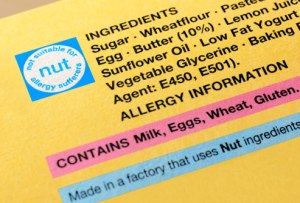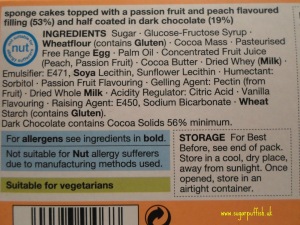 A YEAR or so back, I ambled along to our local park cafe – newly refurbed, ponced-up and handed to a big name London catering firm – and fancied buying myself a coffee and a cake.
A YEAR or so back, I ambled along to our local park cafe – newly refurbed, ponced-up and handed to a big name London catering firm – and fancied buying myself a coffee and a cake.
Unable to eat nuts around Sidney, I asked the girl on the counter if she could tell me please what was in the carrot cake; might it contain any nuts, or nut flours? She trotted off to ask the chef. Minutes later, the reply came back: “The chef can’t tell you what’s in the cake. His recipes are secret.”
Needless to say that particular ‘chef’ was a twat, but it’s heartening to know that as of tomorrow this kind of response will be flat-out illegal. It probably always was a bit dodgy but the guidelines are now absolutely crystal clear.
The new regulations
Under the new EU Regulation 1169/2011 – aka the new EU Food Information for Consumers Regulation (FIR) – any catering business will have to have full and correct information on the 14 major allergens contained within its products.
The 14 major allergens are:
- Cereals containing gluten (eg wheat, spelt, barley, rye and oats)
- Crustaceans such as prawns, crabs, lobster and crayfish
- Eggs
- Fish
- Peanuts
- Soybeans
- Milk
- Nuts (almonds, hazelnuts, walnuts, pecan nuts, brazil nuts, pistachio, cashew, macadamia or queensland nuts)
- Celery
- Mustard
- Sesame
- Sulphur dioxide or sulphites (often found in dried fruit and wine)
- Lupin
- Molluscs like clams, scallops, squid, mussels, oysters and snails
The good bits
Now, I have my reservations about the new laws for various reasons but the good things, as far as I can see, are as follows:
* If you walk into any catering establishment and ask what allergens any of its foods or dishes contain, they have to be able to tell you. They can tell you verbally, or have the information written down, but there must be clear signposting to advise you how you can get this information from staff.
* Nobody can say ‘er, I dunno’ or ‘I’m so up my own ass about my bog standard scone recipe that I can’t tell you what’s in it’. They have to tell you if the food contains any of the 14 major allergens. They have to be accurate. If they are not, you can report them to the food environmental health team of your local authority or the Food Standards Agency.
* It means that every catering establishment will have to have at least this rudimentary understanding of the notion of allergens and what the biggies are. That’s a first step in the right direction.
* Every restaurant will have to list ALL of the most common allergens. I’ve lost count of the number of times I’ve tried to find out if a dish contains sesame (I’m thinking chains such as ASK, or Zizzi) and hit a blank.
Pre-packed food labels will change
The new laws also cover pre-packed foods, such as those sold in supermarkets. These foods will have to have the major 14 allergens clearly highlighted within the ingredients list (for example in bold). Be warned – it means the end of the old allergen ‘box’, stating ‘Contains: milk, eggs, whatnot’. We will no longer have this shorthand and will have to scrutinise the ingredients list to check for allergens. Bear in mind, too, that this information will be phased in, as some foods with a long shelf life will still not have switched over to the new-style labelling.
This is the old way, courtesy of M&S:
This is the new (courtesy of M&S and beauty, allergy and eczema blogger Sugarpuffish):
There are some very complicated and disputed bits to this law, which I won’t go into here but which ‘Health Journo’ and Coeliac expert Alex Gazzola covers brilliantly in his blog. It isn’t quite as straightforward as it sounds, and manufacturers – even the biggies – are still getting this wrong.
The less good bits
BUT.
Despite claims that this will revolutionise the way we eat out and shop as allergic consumers, I still have massive reservations. These include:
* It is still not compulsory for caterers to learn about allergen control and cross contamination. Without this becoming an obligatory part of basic hygiene certification (i.e. without chefs and caterers having to pass a module in how to guard against contamination) I don’t have huge confidence that the vast majority of outlets will be able to safely cater. They will be:
(a) scared, where they actually don’t need to be – catering for allergies is not a dark art, but many are petrified of the consequences because they don’t understand what simple steps they can take
(b) confused about what constitutes cross contamination (I once had a manager in a John Lewis cafe tell me their food was unsafe because there were nuts stored in an adjacent room. Possibly they were flying nuts but you’d think she would have mentioned it…)
(c) in some cases not shit-giving enough to do anything but the absolute minimum – i.e. list the allergens but not try to cater for the allergic.
* There is nothing to legislate for the bane of our lives – ‘may contain’ labelling. There are Food Standards Agency guidelines that note there should be “significant and demonstrable risk” for a product to bear the warning ‘may contain nuts’ or ‘sesame’ or x allergen. But there is no law to govern this, therefore it is still perfectly possible (if inadvisable) for a food manufacturer or supplier to state ‘may contain nuts’ etc where no genuine risk of cross contamination exists.
The divs
There are some amazingly wonderful people out there who go the extra mile to cater for allergy (and I’ll be posting about those that we have found, very soon), but there are also some divs out there huffing and puffing about the ‘extra admin’. I’m thinking of Stuart Atkinson, ‘VP’ of the National Federation of Fish Friers, whose empathy at the end of this Guardian report is heart-warming. As he puts it:
“This is yet another administrative burden placed on small businesses… Once all the interest in the new regulations dies down, we are still stuck with them.”
Yes, it’s sort of the point that the regulations last longer than a fortnight.
“Constant vigilance will be required on receipt of deliveries in case a supplier has altered a pie recipe, for example.There is no requirement for fish friers to be directly informed of any changes to the ingredients of the products we buy, other than the list of ingredients on the packaging. We must therefore check every delivery for any changes to this list.”
Welcome to our world.
Stuff worth remembering
Some other points to bear in mind:
* Unless they are a registered food business, charity cake sales and voluntary bake events are exempt. The Food Standards Agency’s Technical Guidance Notes here state that: “Individuals who are not food businesses and occasionally provide food at charity events or voluntary cake sales, for example, do not need to follow these requirements.”
* The new regulations are NOT a substitute for asking all the questions you should usually ask. Don’t assume that you can walk into any restaurant or cafe and eat safely if your allergen isn’t listed as an ingredient. Talk to the manager and, ideally, the chef. Explain your allergy/allergies and that you need your food to be prepared away from those allergens, and can’t eat food that ‘may contain’ any of the allergens. Explain the severity of your allergy. This checklist from the Anaphylaxis Campaign is helpful.
The responsibility is ours
At the end of the day, much of the responsibility still – rightly – lies with us as allergic consumers. It is down to us to explain what we need, clearly and fully, and down to us to help to educate others out there about how they can best cater for us safely.
So I’ll be viewing the new regulations with a healthy suspicion: as a good first step but far from perfect. I’ll be quick to praise and thank those who get on top of the new regulations and go the extra mile to cater for us, and I’ll be bracing myself to do the other with those that don’t.
As fellow allergy blogger @allergymumscouk put it on Twitter: “What’s the saying? ‘Walk quietly but carry a big stick'”.
Batons at the ready…
Extra resources: The Food Standards Agency’s advice to consumers leaflet is here, and its guidance for small and medium food businesses on the requirements for loose foods is here



